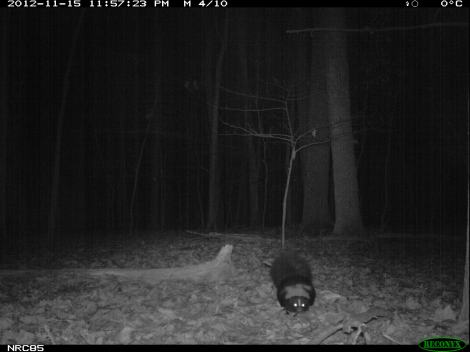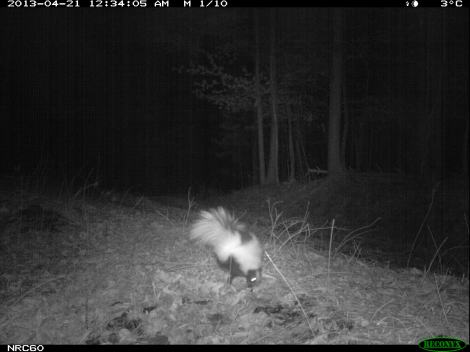The striped skunk (Mephitis mephitis) is widely known for its ability to spray when it feels threatened. Skunks can spray a noxious oily substance up to 16 feet with surprising accuracy, and usually aim for the eyes of the predator that is harassing them. Their spray contains sulfuric acid so a direct shot to the eyes will cause temporary blindness.
Because of this defense striped skunks are relatively fearless and will forage throughout their home range without regard to activity of predators, although they are still occasionally killed by foxes, bobcats, and great horned owls. Striped skunks are almost entirely nocturnal, although they can be seen in the early morning or late evening and sometimes will forage on overcast days.
Skunks forage throughout their home range on regular routes, often walking the same paths for several days before moving to a new area. They use their nose to find food, and are very omnivorous. Their diet changes with the season but they eat insects, mollusks, small reptiles, and amphibians and have been known to occasionally catch mice. This occasional act of predation is rare, and they do not prey on larger mammals or reptiles.
Striped skunks are very strong diggers, and use their long claws on their front feet to dig for insect prey. The inner toes on the front feet of skunks are also fused to support for vigorous digging. Skunks will dig for grubs and worms, leaving surprisingly small holes across the landscape. Skunks also dig up yellow jacket and ground wasp nests to eat both larvae and adults. They have even been known to agitate a nest and swat down adults as they emerge and eat them! Striped skunks seem to be immune or highly resistant to yellow jacket venom but some skunks have died from bee stings.
Skunks will also opportunistically feed on bird nests they find on the ground, although they have trouble breaking the larger eggs from turkeys or grouse, and may use their paws to throw the eggs against a hard surface to break them. In the fall skunks will eat large amounts of fruit if available.
For more information and pictures of striped skunks see:
ARKive (pictures only no information)
Sources
Elbroch, Mark and Kurt Rinehart. Behavior of North American Mammals. New York: Houghton Mifflin, 2011. 374 pgs.
Wade-Smith, J. and B. J. Verts. 1982. Mephitis mephitis. Mammalian Species. 173:1-7.



Very interesting; thank you!
Pingback: Why skunks stink, new research | Dear Kitty. Some blog·